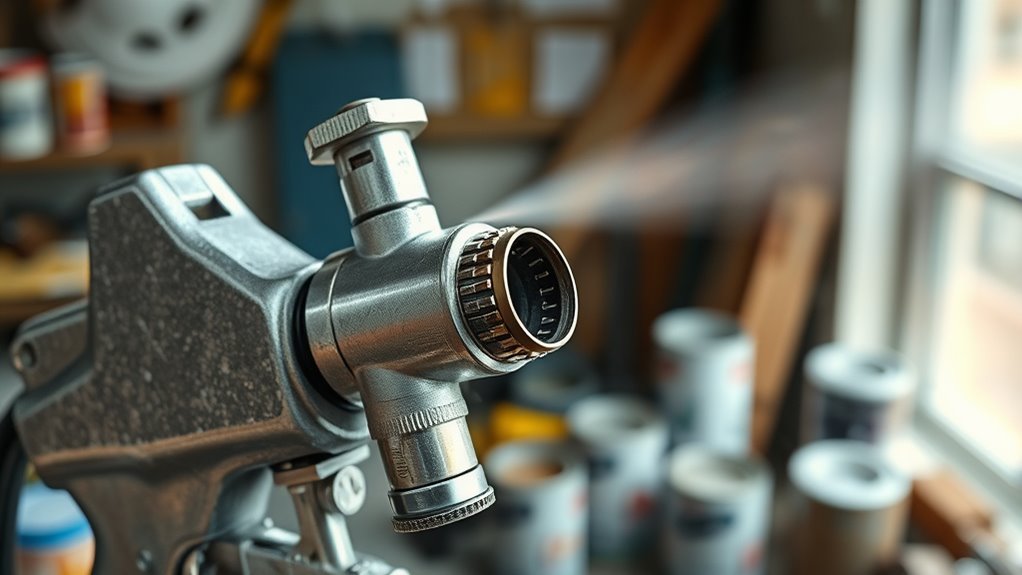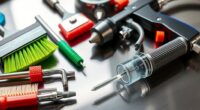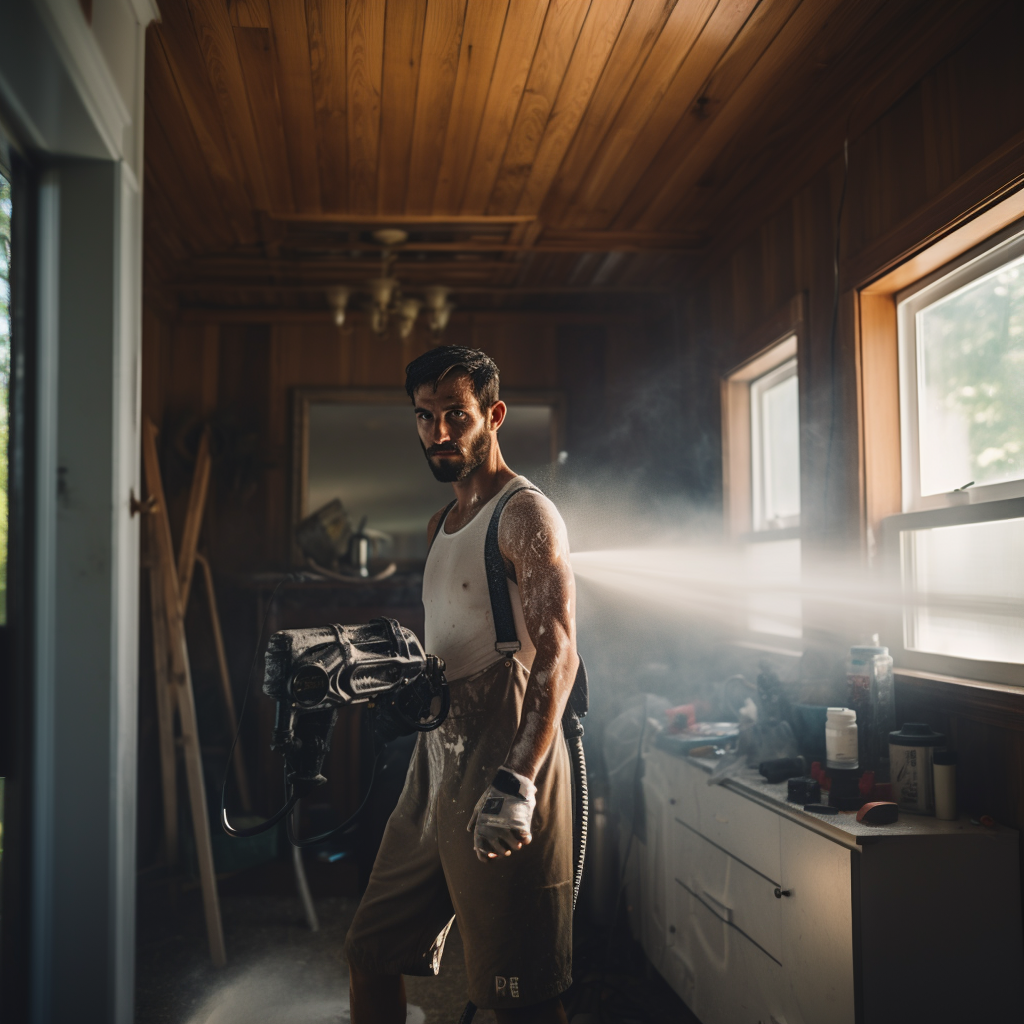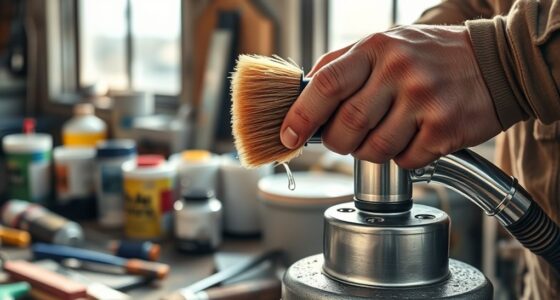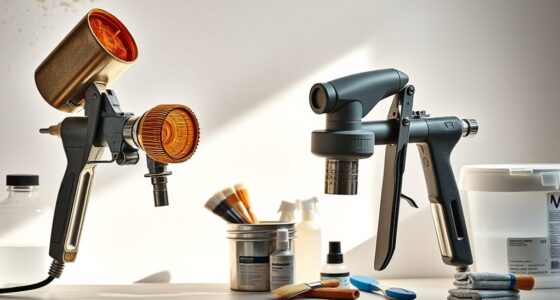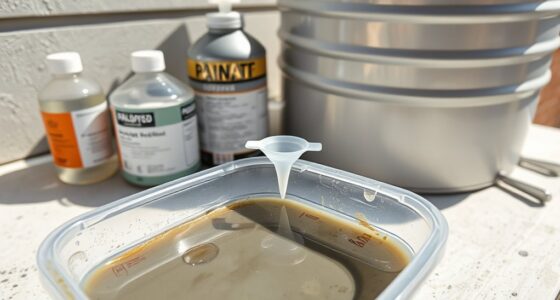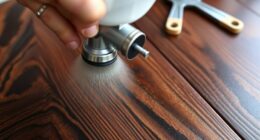If your paint sprayer is losing pressure, it’s likely due to clogs from dried or thickened paint, leaks in hoses or fittings, or mechanical issues with the pump or motor. Blockages restrict paint flow, while leaks or damaged hoses lower pressure. Mechanical faults can also hinder performance. Ensuring regular cleaning, inspecting for damage, and maintaining your equipment can often fix these problems. Keep exploring to uncover more tips on keeping your sprayer working smoothly.
Key Takeaways
- Check for nozzle blockages or dried paint buildup that restricts flow and clean them thoroughly.
- Inspect hoses and connections for leaks, cracks, or loose fittings that cause pressure loss.
- Ensure the air compressor is functioning properly with sufficient airflow and no kinks in the hose.
- Examine the pump and motor for wear, damage, or overheating that may reduce pressure output.
- Perform regular maintenance, including cleaning, replacing worn seals, and proper storage, to prevent pressure issues.
Common Mechanical Blockages and Clogs

Mechanical blockages and clogs are common reasons for a paint sprayer losing pressure. When the paint flow is restricted, your sprayer can’t operate efficiently, leading to uneven spray patterns or complete pressure loss. One frequent cause is nozzle blockages, which can occur if paint dries or thickens inside the nozzle, obstructing the spray. Debris or dried paint may also clog the fluid passages, reducing flow. To fix this, inspect the nozzle and clean it thoroughly with a brush or solvent, ensuring no residual paint remains. Check for any debris or hardened paint in the fluid inlet or hose. Regular maintenance prevents these blockages, keeping your paint flow steady and your sprayer working at ideal pressure. Additionally, understanding the different types of clogs can help you diagnose and address issues more effectively. Proper cleaning and preventive care are crucial to avoid recurring problems and maintain optimal performance. Being aware of potential blockage causes, such as dried paint or debris buildup, can also help you take proactive steps to prevent pressure loss. Regularly inspecting and maintaining your spray system can significantly reduce the likelihood of pressure issues caused by mechanical obstructions. Incorporating cleaning routines into your maintenance schedule can further reduce the risk of clogs and ensure consistent spray quality.
Air Supply Issues and Pressure Loss
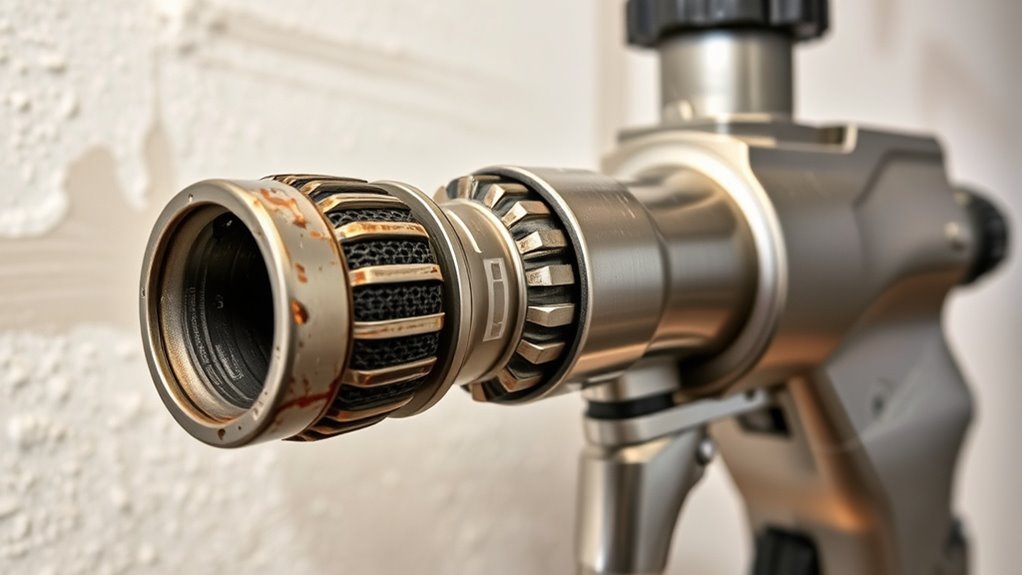
Air supply problems are a common cause of pressure loss in paint sprayers. If your sprayer isn’t maintaining proper pressure, check your air compressor first. Make sure it’s providing enough airflow and that the pressure settings align with your sprayer’s requirements. Use a pressure gauge to verify the compressor’s output; if the gauge shows low pressure, your compressor may need adjustment or repair. Also, inspect the air hose for kinks or blockages that could restrict airflow. Insufficient air supply reduces the pressure reaching your sprayer, resulting in uneven spray and poor finish. Regularly monitoring your pressure gauge can help you catch issues early, preventing pressure drops before they affect your project. Proper maintenance of your air compressor and hoses is key to consistent pressure and ideal spraying. Additionally, understanding the importance of air compressor efficiency can significantly improve your spraying consistency and quality. Ensuring proper maintenance of your equipment can help prevent pressure loss and extend the lifespan of your tools. Paying attention to hose connections can also prevent leaks that reduce pressure and hinder performance. A well-maintained system with optimal airflow management ensures steady pressure and better spraying results.
Leaks in Hoses and Connections
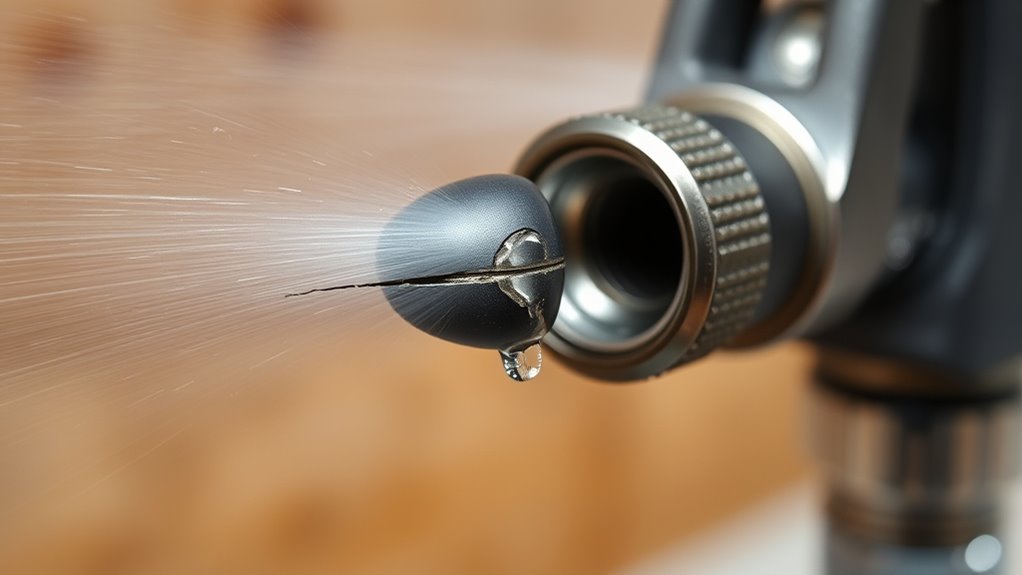
Leaks in hoses and connections are a common culprit behind pressure drops in paint sprayers. When hose integrity is compromised or connections aren’t tight enough, air and paint can escape, reducing pressure. Regularly inspect your hoses for cracks or bulges, and ensure all fittings are securely tightened. A well-maintained hose system prevents pressure loss, extending the lifespan of your equipment and maintaining consistent spray quality. Imagine a visual breakdown:
| Hose Condition | Connection Tightness | Pressure Impact |
|---|---|---|
| Cracked or worn | Loose fittings | Pressure loss |
| Intact and flexible | Tight fittings | Ideal pressure |
| Kinks or blockages | Slightly loose | Reduced flow |
| Damaged fittings | Properly tightened | Stable pressure |
Additionally, monitoring your hose condition regularly helps identify early signs of deterioration that could lead to leaks. Ensuring proper hose maintenance and timely replacements can prevent unexpected pressure drops and prolong equipment life. Properly maintained hoses are less likely to develop leaks, which is essential for consistent spray performance. Maintaining hose integrity and connection tightness keeps your sprayer functioning at peak performance, preventing pressure dips caused by leaks. Regular maintenance also helps prevent hose deterioration, which can lead to more frequent pressure issues.
Pump and Motor Malfunctions
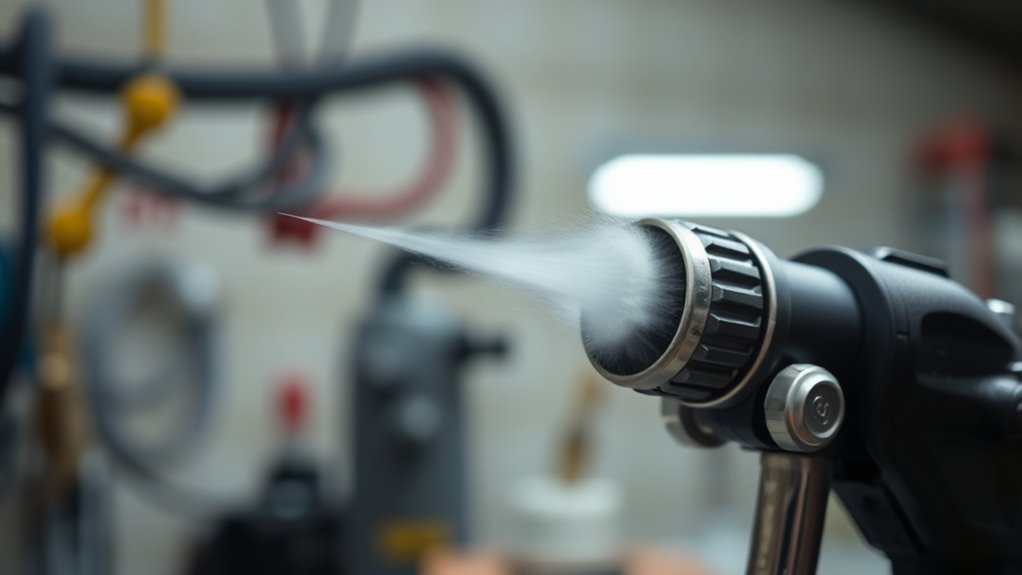
Pump and motor malfunctions are common causes of pressure loss in paint sprayers. If your pump experiences failure, it can’t generate the necessary pressure to spray evenly. Pump failure might result from worn-out seals, clogged components, or a damaged piston. Additionally, motor overheating can cause your sprayer’s motor to slow down or shut off to prevent damage, leading to inconsistent pressure. Over time, extended use or debris buildup can lead to overheating issues. To troubleshoot, check for unusual noises, excessive heat, or sluggish operation. Ensuring proper maintenance, like cleaning filters and avoiding overuse, can prevent pump failure and motor overheating. Regular inspection and timely repairs are essential for maintaining optimal performance, and understanding Kia Tuning can help you better diagnose vehicle-related issues. Addressing these issues promptly helps restore consistent pressure and keeps your sprayer functioning smoothly.
Maintenance and Regular Care Tips

Regular maintenance is key to preventing pressure loss in your paint sprayer. To keep it running smoothly, follow cleaning tips such as thoroughly rinsing components after each use, especially the sprayer’s nozzle and filters, to prevent clogs. Regularly inspecting and replacing worn seals and hoses also helps maintain consistent pressure. Proper storage practices are equally important; store your sprayer in a dry, cool place, and empty any residual paint to prevent drying and buildup inside the system. Keep your equipment protected from dust and debris by covering it when not in use. Performing these routine tasks ensures your sprayer remains in peak condition, reducing the chances of pressure drops and prolonging its lifespan. Incorporating top maintenance solutions can further optimize performance and prevent issues before they arise, while paying attention to skincare patch application timing can help you achieve better results with your treatments. Additionally, understanding AI security concepts can help you better safeguard your equipment from cyber threats. Regularly checking the industrial juice manufacturing process can also be beneficial if your equipment involves similar procedures, ensuring all components are functioning correctly. Moreover, keeping an eye on Security Zone Info can help you stay informed about best practices for safeguarding your tools and data.
Frequently Asked Questions
Can Temperature Changes Affect My Paint Sprayer’S Pressure?
Temperature fluctuations can definitely affect your paint sprayer’s pressure. When it gets colder, paint viscosity increases, making it thicker and harder to spray smoothly. Conversely, warmer temperatures lower viscosity, which can cause the sprayer to lose pressure or spray unevenly. Keep your paint at a consistent temperature to maintain proper pressure, and avoid sudden temperature changes that can lead to inconsistent spraying or clogging.
Is It Normal for Pressure to Fluctuate During Prolonged Use?
It’s common for pressure fluctuations to happen during prolonged use of your paint sprayer. As you work, nozzle clogging can cause inconsistent pressure, making the spray less even. To maintain steady pressure, regularly check and clear clogs from the nozzle, and avoid running the sprayer for too long without breaks. Proper maintenance and cleaning help prevent pressure drops, ensuring your painting stays smooth and professional-looking throughout the job.
How Do I Identify if My Spray Tip Is Worn Out?
To identify if your spray tip is worn out, examine the spray tip closely for visible signs of wear, such as rough edges or a distorted shape. Use a wear indicator if available, which helps you spot uneven spray patterns or reduced coverage. If the spray pattern is inconsistent or the paint gushes out unevenly, it’s time to replace the spray tip. Regularly inspecting your spray tip prevents pressure issues and guarantees smooth operation.
Can Using Incompatible Paint Affect Pressure Consistency?
Using incompatible paint can definitely affect pressure stability. When you choose a paint that’s too thick or not designed for your sprayer, it forces the machine to work harder, causing pressure issues. Always check paint compatibility with your sprayer’s specifications. If the paint isn’t suitable, you might notice inconsistent spray patterns or pressure drops. To maintain ideal performance, stick to recommended paints and adjust settings as needed.
What Safety Precautions Should I Take During Maintenance?
During maintenance, you should prioritize equipment safety by unplugging the sprayer and releasing pressure before starting. Follow proper maintenance protocols, such as wearing gloves and eye protection to avoid injuries. Make certain all parts are clean and in good condition, and handle chemicals carefully. Always read the manufacturer’s instructions to prevent accidents, and work in a well-ventilated area. These precautions keep you safe and keep your equipment functioning properly.
Conclusion
So, next time your paint sprayer decides to throw a tantrum and lose pressure, just remember—it’s probably just throwing a little mechanical hissy fit. Maybe it’s clogged, breathless, or secretly plotting leaks. Treat it with some love and a quick check-up, or it might start demanding a spa day with new parts. After all, your sprayer isn’t just a tool; it’s a diva in disguise, craving attention and maintenance.
Franz came aboard the Paint Sprayer Zone team with a background in both journalism and home renovation. His articulate writing style, combined with a passion for DIY projects, makes him an invaluable asset. Franz has a knack for breaking down technical jargon into easy-to-understand content, ensuring that even the most novice of readers can grasp the complexities of paint sprayers.
